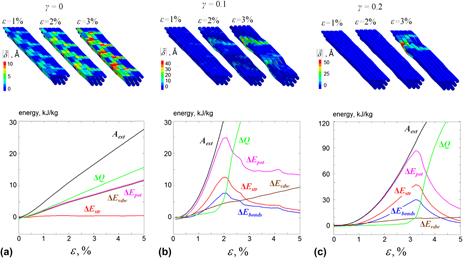Crossref Citations
This article has been cited by the following publications. This list is generated based on data provided by
Crossref.
2016.
Coupled CFD‐DEM Modeling.
p.
372.
Wang, Yuezhou
Drozdov, Grigorii
Hobbie, Erik K.
and
Dumitrica, Traian
2017.
Excluded Volume Approach for Ultrathin Carbon Nanotube Network Stabilization: A Mesoscopic Distinct Element Method Study.
ACS Applied Materials & Interfaces,
Vol. 9,
Issue. 15,
p.
13611.
Alzaid, Meshal
Roth, Joseph
Wang, Yuezhou
Almutairi, Eid
Brown, Samuel L.
Dumitrică, Traian
and
Hobbie, Erik K.
2017.
Enhancing the Elasticity of Ultrathin Single-Wall Carbon Nanotube Films with Colloidal Nanocrystals.
Langmuir,
Vol. 33,
Issue. 32,
p.
7889.
Wang, Yuezhou
Xu, Hao
Drozdov, Grigorii
and
Dumitrică, Traian
2018.
Mesoscopic friction and network morphology control the mechanics and processing of carbon nanotube yarns.
Carbon,
Vol. 139,
Issue. ,
p.
94.
Chen, Xiuyu
Huang, Guoqin
Tan, Yuanqiang
Huang, Hui
Guo, Hua
and
Xu, Xipeng
2018.
Model Establishment of a Co-Based Metal Matrix with Additives of WC and Ni by Discrete Element Method.
Materials,
Vol. 11,
Issue. 11,
p.
2319.
Drozdov, Grigorii
Xu, Hao
Frauenheim, Thomas
and
Dumitrică, Traian
2019.
Densely-packed bundles of collapsed carbon nanotubes: Atomistic and mesoscopic distinct element method modeling.
Carbon,
Vol. 152,
Issue. ,
p.
198.
Ostanin, Igor
Dumitrică, Traian
Eibl, Sebastian
and
Rüde, Ulrich
2019.
Size-Independent Mechanical Response of Ultrathin Carbon Nanotube Films in Mesoscopic Distinct Element Method Simulations.
Journal of Applied Mechanics,
Vol. 86,
Issue. 12,
Volkov, Alexey N.
and
Banna, Abu Horaira
2020.
Mesoscopic computational model of covalent cross-links and mechanisms of load transfer in cross-linked carbon nanotube films with continuous networks of bundles.
Computational Materials Science,
Vol. 176,
Issue. ,
p.
109410.
Gspann, Thurid S.
Kaniyoor, Adarsh
Tan, Wei
Kloza, Philipp A.
Bulmer, John S.
Mizen, Jennifer
Divitini, Giorgio
Terrones, Jeronimo
Tune, Daniel
Cook, John D.
Smail, Fiona R.
and
Elliott, James A.
2021.
Catalyst-Mediated Enhancement of Carbon Nanotube Textiles by Laser Irradiation: Nanoparticle Sweating and Bundle Alignment.
Catalysts,
Vol. 11,
Issue. 3,
p.
368.
Banna, Abu Horaira
Kayang, Kevin W.
and
Volkov, Alexey N.
2021.
Effects of the nanotube length and network morphology on the deformation mechanisms and mechanical properties of cross-linked carbon nanotube films.
Journal of Applied Physics,
Vol. 129,
Issue. 10,
Asadollahi, Davoud
and
Shariati, Mahmoud
2021.
Investigation of shear forces in twisted carbon nanotube bundles using a structural mechanics approach.
Acta Mechanica,
Vol. 232,
Issue. 6,
p.
2425.
Kayang, Kevin W.
Banna, Abu Horaira
and
Volkov, Alexey N.
2022.
Chirality-Dependent Mechanical Properties of Bundles and Thin Films Composed of Covalently Cross-Linked Carbon Nanotubes.
Langmuir,
Vol. 38,
Issue. 6,
p.
1977.
Kataria, Aditya
Wang, Yuezhou
Mujumdar, Kedar
and
Dumitrică, Traian
2023.
Influence of polymeric and cross-linked nano-hole interfaces on the tensile response of carbon nanotube bundles: A mesoscopic distinct element method approach.
Extreme Mechanics Letters,
Vol. 65,
Issue. ,
p.
102108.
Kataria, Aditya
Liang, Zhiyong
and
Dumitricǎ, Traian
2023.
Computational Investigation of Interacting Nanohole Defects for Carbon Nanotube Cross-Linking and Functionalization with Bismaleimide: Implications for Ultrastrong, Lightweight Nanocomposites.
ACS Applied Nano Materials,
Vol. 6,
Issue. 8,
p.
6474.
Park, Jin Gyu
Evers, Cecil
Jolowsky, Claire
Vondrasek, Britannia
Thagard, Kaylee
Czabaj, Michael
Ku, Bailee
Wang, Yuezhou
Dumitrică, Traian
Odegard, Gregory M.
and
Liang, Zhiyong
2024.
Gamma-ray irradiation to achieve high tensile performance of unidirectional CNT yarn laminates.
Carbon,
Vol. 216,
Issue. ,
p.
118530.





